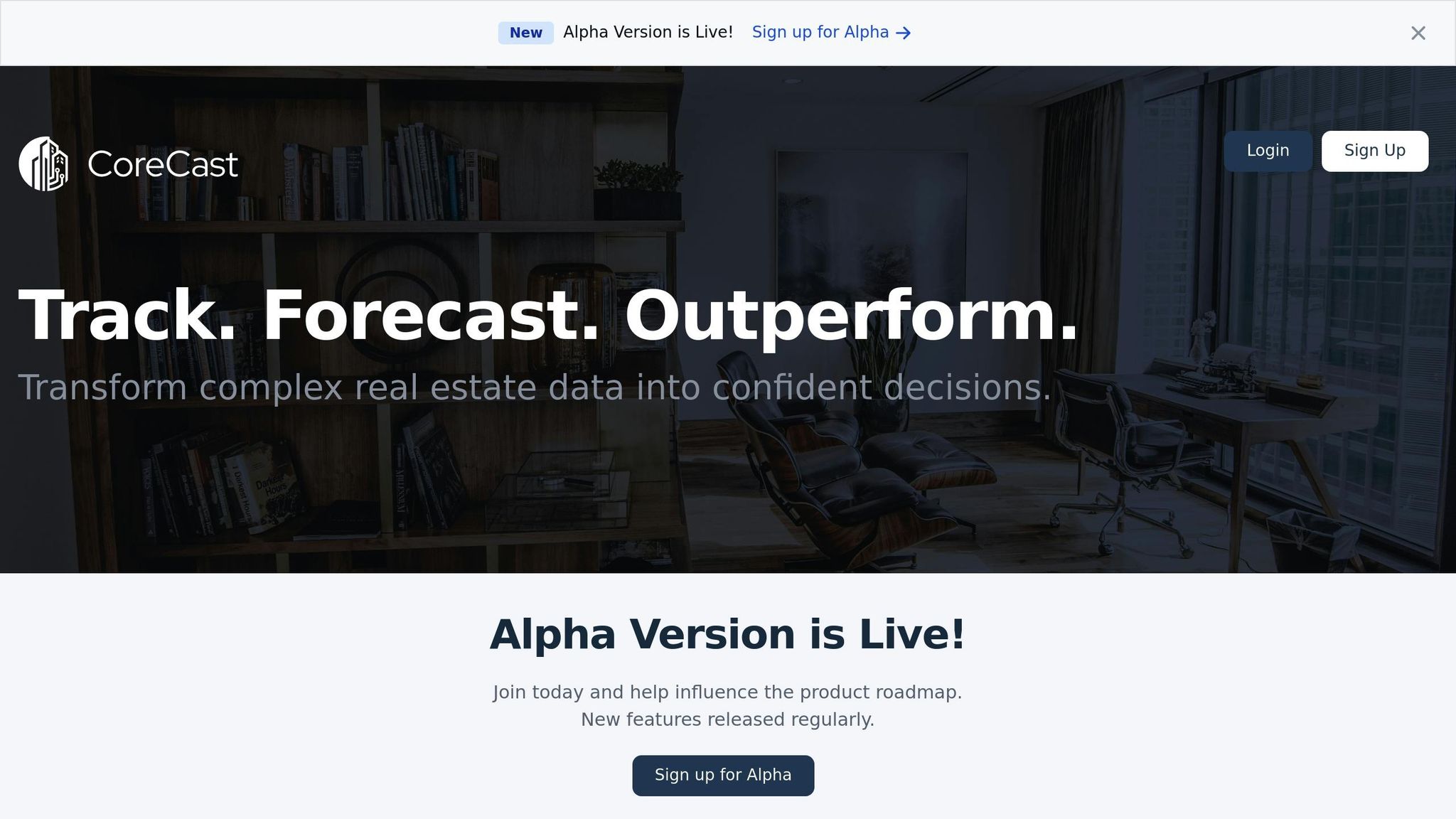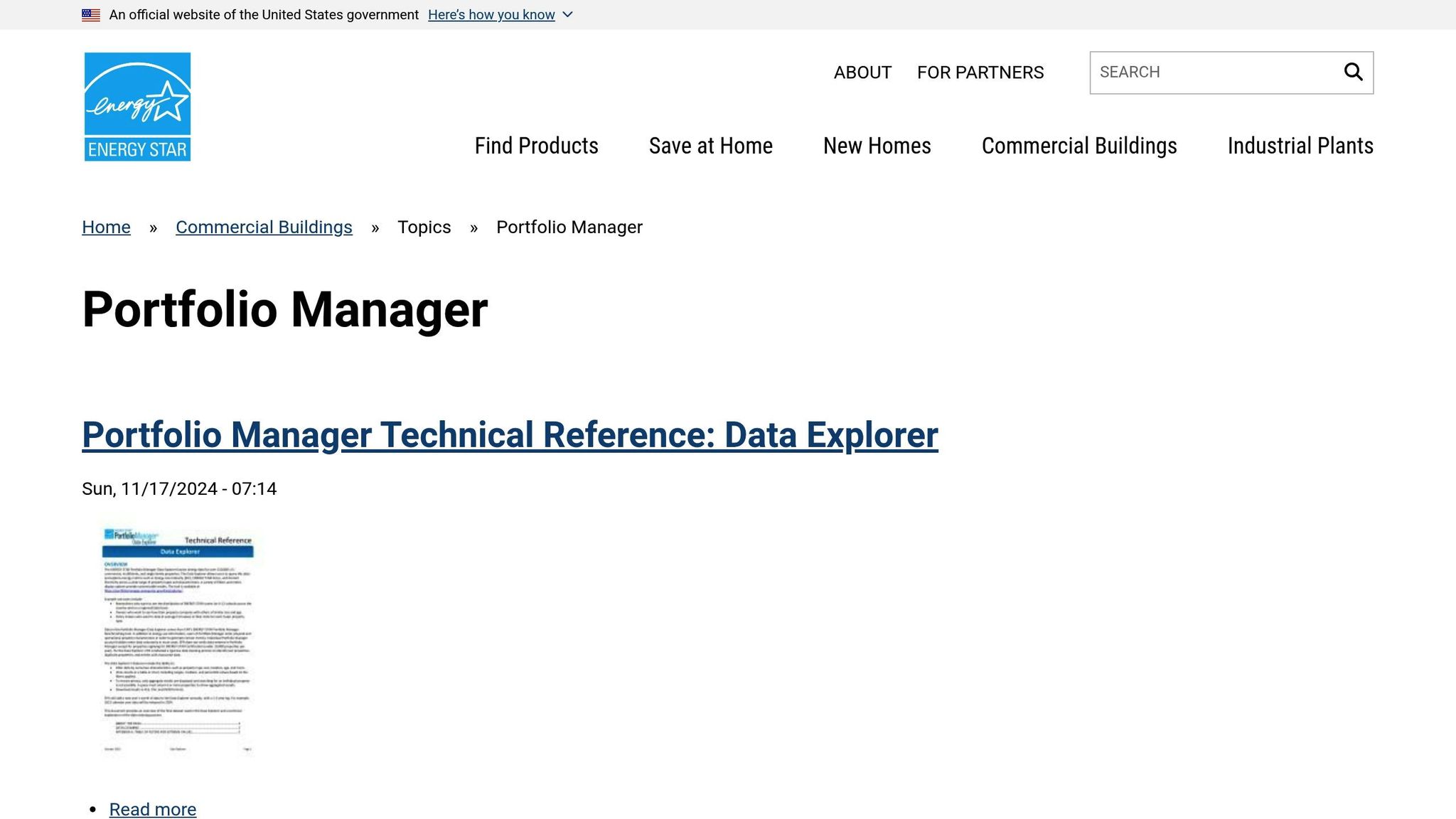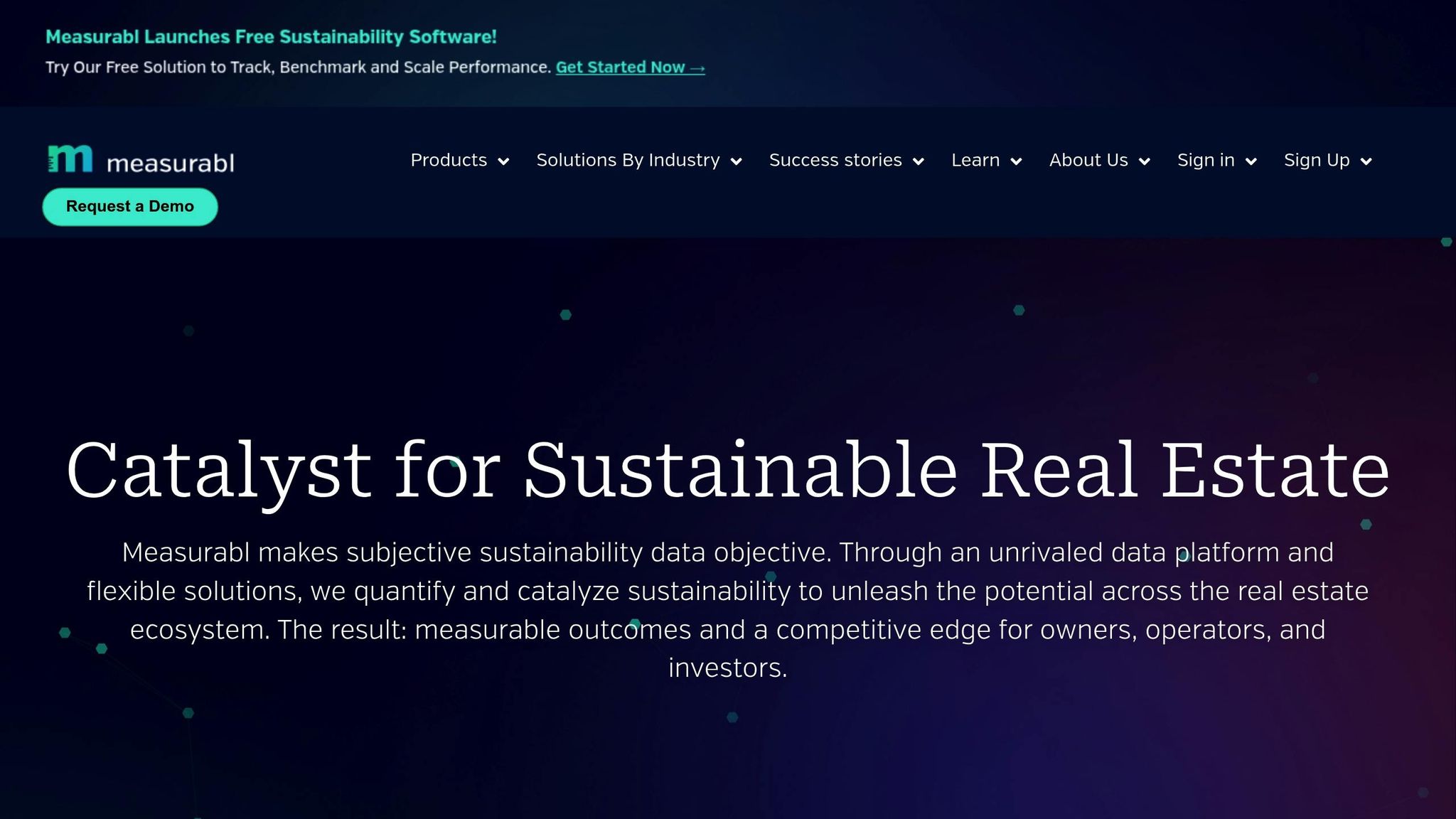Energy Data Analytics for Real Estate Decisions
Energy data analytics is transforming how real estate professionals manage properties, cut costs, and meet sustainability goals. By analyzing energy consumption, predictive insights, and regulatory trends, these platforms help optimize building performance and improve decision-making.
Key insights:
- The energy analytics market is projected to grow from $5.1 billion in 2025 to $11.48 billion by 2030 at a 17.68% annual growth rate.
- Platforms enable real-time tracking, predictive maintenance, and compliance with regulations like zero-emission building mandates.
Top Platforms:
- CoreCast: Combines energy and financial data for real estate decisions. Offers real-time insights, forecasting, and seamless integration for $50–$105/user/month.
- Energy Star Portfolio Manager: Free EPA tool for benchmarking energy performance, widely used for compliance and certifications.
- Measurabl: Advanced ESG-focused platform for large portfolios, providing real-time data, automation, and global benchmarking.
Quick Comparison:
| Feature | CoreCast | Energy Star Portfolio Manager | Measurabl |
|---|---|---|---|
| Price | $50–$105/user/month | Free | Custom pricing |
| Focus | Real estate intelligence | Benchmarking and compliance | ESG and energy |
| Data Updates | Real-time | Manual/periodic | Frequent automated |
| Best For | Investment decisions | Compliance | Large portfolios |
Each platform has strengths tailored to specific needs, from cost-effective compliance to advanced analytics for large-scale operations. Choose based on your portfolio size, goals, and integration requirements.
FUNKE Mediengruppe - When real estate meets data analytics for energy efficiency

1. CoreCast

CoreCast is an all-in-one real estate intelligence platform designed to transform property data into actionable energy insights. Currently available in beta for $50 per user per month (with an anticipated increase to $105 per user per month after its full release), this platform combines various analytical tools into a single dashboard, making it easier for real estate professionals to make energy-conscious decisions.
Real-time Insights
CoreCast simplifies energy management by consolidating data into a real-time dashboard. This feature provides users with an instant snapshot of their portfolio's performance, benchmarking it against market standards using live data. By eliminating the need for manual data collection, it saves time and improves efficiency. Companies utilizing asset performance monitoring have reported impressive results, including a 22% reduction in maintenance costs, a 15% increase in equipment uptime, and a 25% boost in labor productivity.
Kimberly Gangi, Head of the Outsource Accounting Services Group, highlights the value of benchmarking:
"Benchmarking allows you to pinpoint areas where your property outperforms competitors and areas where improvement is needed, so you can focus resources on areas with the greatest potential for enhancement."
The platform also provides dynamic performance metrics across different timeframes. This allows teams to track energy consumption trends, spot anomalies in systems like HVAC or lighting, and compare performance across properties. These real-time insights pave the way for accurate energy forecasting.
Energy Trend Forecasting
CoreCast makes it easy to toggle between current data and future forecasts, delivering the precision needed for informed energy management decisions. This capability is especially critical given the building sector's significant energy demands. With accurate forecasts, facility managers can plan ahead, shifting energy-heavy activities to off-peak hours to save on costs.
Integration Capabilities
Understanding that 97% of companies integrate external data feeds into their facility management systems, CoreCast focuses on seamless compatibility with existing property management tools. Don Bleaney, Senior Director at One11 Advisors, underscores the importance of integration:
"Enter it once and use it many times. Ideally, you want data to be able to be shared with every system in your environment from asset management to accounting. Each group should be able to look at that data from their own lens and apply what is important to them."
This approach minimizes data silos and ensures a smooth flow of information across different operational systems. The result is more comprehensive energy trend analysis and improved overall efficiency.
Reporting and Automation
CoreCast also excels in reporting and automation. It offers personalized, branded reports that can be automatically distributed to key stakeholders, simplifying communication. This feature is particularly valuable, given that only about 40% of organizations currently have the ability to automatically source sustainability data.
Amy Tippet, Senior Solutions Architect, emphasizes the importance of consistency in data:
"Repeatable data is important for forecasting. You need to be able to get data from one source on a regular basis so you don't have to rewrite templates and reports every time."
With automated reporting and seamless integration, CoreCast helps businesses streamline operations, enhance decision-making, and stay ahead in energy management.
2. Energy Star Portfolio Manager

Energy Star Portfolio Manager is the U.S. Environmental Protection Agency's (EPA) official tool for tracking energy performance nationwide. With over 450,000 buildings benchmarked, it has become a key resource for standardized energy analytics across the country. In fact, nearly 25% of all U.S. commercial building space actively uses Portfolio Manager for benchmarking purposes.
Real-Time Monitoring
This tool offers robust tracking for energy and water consumption, along with monitoring greenhouse gas emissions. By systematically tracking performance across building portfolios, it helps identify specific opportunities to reduce energy use.
One standout feature is its alert system, which flags errors in energy, water, and waste metrics. These alerts help property managers quickly address issues that could result in invalid ("N/A") data.
Portfolio Manager's benchmarking capabilities have a proven impact. ENERGY STAR-certified buildings, for example, consume and emit 35% less energy and carbon dioxide compared to typical buildings. The platform also integrates with existing systems to improve operational efficiency seamlessly.
Integration Features
Portfolio Manager supports flexible data management options, including manual entry, spreadsheet uploads, and a powerful web services API for streamlined data exchange. The EPA's application programming interface (API) allows users to import customer data directly into Portfolio Manager accounts or export metrics to third-party software. ENERGY STAR Web Services Providers that integrate with the tool can display the "Works with Portfolio Manager" badge, showcasing their compatibility.
Reporting and Automation
As the national benchmarking platform for both the United States and Canada, Portfolio Manager plays a critical role in energy reporting. Many jurisdictions require large commercial and multifamily properties to report their annual energy usage using this tool. ENERGY STAR benchmarks are also central to most building performance standards across North America.
To ensure accurate assessments, properties need at least 12 months of continuous data structured according to ENERGY STAR guidelines. It's worth noting that ENERGY STAR certification is valid for just one year, so properties must reapply annually to maintain their certification status.
sbb-itb-99d029f
3. Measurabl

Measurabl processes an impressive 35,000 utility bills every month and manages over 21 billion square feet of property worldwide. It delivers data at twice the speed while reducing gaps by 25% - a clear testament to its efficiency .
Real-Time Insights
With Measurabl Optimize, energy data is captured every five minutes, providing highly detailed insights into energy consumption, costs, and carbon emissions. This level of granularity allows for immediate actions to improve efficiency. By centralizing data from portfolios, properties, utilities, and third-party sources, the platform delivers verified insights that help improve performance and move closer to net-zero goals . Additionally, real-time grid emissions data enables operational adjustments without waiting for monthly utility bills.
"As a global owner and operator of world-class assets, it's critical that we adapt our operating approach to the unique needs of each property. Measurabl's versatility across our portfolio - collecting bill data, meter data, and equipment information - enables us to deliver above expectation."
– Chad Engle, Vice President, Corporate Engineering, Hines
In April 2025, Unico Properties achieved ongoing energy efficiency and cost savings by leveraging Measurabl Optimize to compare real-time data with historical trends and uncover optimization opportunities .
Integration Capabilities
The platform’s real-time insights directly support its integration features. Measurabl syncs effortlessly with ENERGY STAR Portfolio Manager, with automated updates every 1–3 days. This two-way synchronization eliminates the need for manual input, ensuring data accuracy. API access further simplifies automated data sharing with other systems. A notable example of its integration power occurred on June 16, 2016, when 630 buildings covering 163 million square feet synced 181 ENERGY STAR certifications on the very first day of deployment. The average ENERGY STAR score for these buildings was an impressive 87 out of 100.
"By enhancing our web integration with EPA's Portfolio Manager we've taken another step towards making it easy to manage, report, and act upon sustainability data."
– Matt Ellis, Measurabl's Founder and CEO
Measurabl also benchmarks building energy performance against a database of 110,000+ global buildings, offering valuable context across different markets and property types.
Reporting and Automation
Measurabl goes beyond basic energy tracking by offering comprehensive ESG compliance and disclosure management. The platform provides investment-grade, audit-ready data with built-in checks to ensure compliance with both local and global standards. Its recommendations have been shown to deliver 10–30% energy savings, powered by machine learning models trained on over a decade of data from more than 1,000 customers worldwide.
Users can create customizable, audit-ready ESG reports that meet standards like GRESB, CDP, and TCFD, all while benefiting from automated processes that simplify reporting . Within just four weeks of launching its free solution, Measurabl onboarded 5,000 buildings spanning 1 billion square feet across 32 countries, showcasing its scalability and global reach.
Advantages and Disadvantages
When it comes to energy data analytics platforms, each option has its own strengths and challenges. Choosing the right one means understanding these trade-offs and aligning them with your organization’s specific needs and goals.
CoreCast is a comprehensive platform that combines energy and financial analytics, making it a powerful tool for real estate investment decisions. It allows users to analyze any asset class while tracking energy performance alongside financial metrics. The platform also includes mapping tools to visualize properties and competitive landscapes. Currently, CoreCast offers beta pricing at $50 per user per month, with future plans ranging from $75 to $100 per user. However, its focus on real estate intelligence sets it apart from platforms that emphasize regulatory compliance or global scalability.
Energy Star Portfolio Manager, on the other hand, stands out for being free and backed by the government. It uses the ENERGY STAR scoring system to provide clear, comparable metrics, which simplifies communication with stakeholders. However, its reliance on manual or periodic data entry and its basic reporting features can make it more time-consuming and less robust for advanced analytics.
Measurabl leverages machine learning to process large-scale data and deliver actionable recommendations for improving energy efficiency. While its advanced features make it ideal for large portfolios, the platform’s complexity can be daunting for smaller organizations or those just starting with energy data analytics.
Here’s a quick comparison of these platforms:
| Feature | CoreCast | Energy Star Portfolio Manager | Measurabl |
|---|---|---|---|
| Data Capture Frequency | Real-time insights | Manual or periodic entry | Frequent automated updates |
| Portfolio Integration | Full real estate intelligence | Energy-focused only | Focused on ESG and energy |
| Benchmarking Database | Competitive landscape mapping | National average benchmarks | Comprehensive global database |
| Pricing | $50–$100/user/month | Free | Enterprise pricing |
| Best For | Investment analysis | Compliance and certification | Large, complex portfolios |
| Learning Curve | Moderate | Low | High |
Interestingly, nearly 60% of real estate professionals now use predictive insights from nontraditional data sources. However, barriers like skill gaps in data analysis, integration challenges, and security concerns still pose significant hurdles as these platforms evolve.
Final Thoughts
When selecting an energy data analytics platform, it's crucial to align it with your business objectives. The global market for real estate business intelligence software is expected to surge from $4.5 billion in 2023 to $15.8 billion by 2032, highlighting the growing role of data-driven decision-making in the real estate sector.
Start with your goals, not just the technology. CoreCast takes a broad approach to real estate intelligence, combining energy performance data with financial metrics across various asset classes. This approach stands out compared to tools that focus solely on compliance.
For basic compliance and benchmarking needs, Energy Star Portfolio Manager offers a reliable, free solution.
Scalability is key. Platforms like Measurabl demonstrate the rising demand for robust sustainability analytics. Matt Ellis, CEO and Co-Founder of Measurabl, emphasized this shift:
"The world has changed. We need to align sustainability with business value in a much more direct, measurable way. To do that, the real estate industry needs easier access to data, the tools to interpret it, and greater accuracy all at far lower cost".
When assessing platforms, look for features that go beyond electricity tracking. Advanced capabilities should include multi-energy source management, energy performance indicator (EnPI) calculation, and adherence to the IPMVP protocol for measurement and verification. Tools for carbon footprint analysis and custom reporting are no longer optional - they’re essential for communicating with stakeholders and meeting compliance requirements.
Don't overlook implementation costs, staff training, and ongoing maintenance. Build teams that blend data expertise with real estate knowledge, and consider starting with pilot projects that deliver measurable outcomes. Operational readiness is just as important as analytical functionality.
Ultimately, the ideal platform will scale with your portfolio while offering the specific energy analytics tools you need to support your investment strategy and operational goals. The key to success lies in finding a solution that matches your unique requirements and evolves alongside your business.
FAQs
How can real estate professionals use energy data analytics to meet sustainability goals and lower costs?
Energy data analytics gives real estate professionals the tools they need to make informed and environmentally conscious decisions. By delivering real-time insights into energy consumption, these tools help pinpoint inefficiencies, improve energy performance, and cut down on waste. The result? Lower operational costs and a step forward in sustainability efforts.
On top of that, energy data analytics plays a key role in meeting environmental regulations and boosting property value through better energy efficiency. Armed with detailed data, professionals can strike a balance between financial objectives and environmental responsibility.
What should I look for in an energy data analytics platform for real estate management?
When selecting an energy data analytics platform for real estate, it's crucial to focus on tools that simplify decision-making and provide practical insights. Look for features like:
- Real-time energy monitoring: Keep tabs on energy use as it happens and quickly identify inefficiencies.
- Predictive analytics: Anticipate future energy consumption to better manage expenses.
- System integration: Ensure the platform works smoothly with your current tools and processes.
- Centralized dashboards: Get a clear, all-in-one view of energy performance across properties.
- Tools to uncover and address the root causes of energy waste.
These capabilities can empower you to make smarter, data-driven choices that boost energy efficiency and enhance property performance.
How can real-time energy monitoring and predictive maintenance improve building performance and support better real estate decisions?
Real-time energy monitoring and predictive maintenance are game-changers when it comes to boosting building performance. These tools help spot energy inefficiencies and catch equipment problems early, which means less operational downtime, lower maintenance expenses, and smarter energy use.
For real estate professionals, this means making better decisions and increasing asset value. Predictive maintenance keeps systems running seamlessly, while real-time insights enable proactive tweaks. Together, they pave the way for smarter investments and long-term savings.

